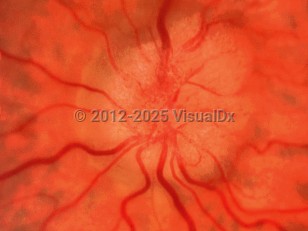Idiopathic intracranial hypertension
See also in: External and Internal EyeAlerts and Notices
Important News & Links
Synopsis

The most common presenting symptom of IIH is headache, occurring in 68%-98% of patients. The headache may be exacerbated by coughing or straining and is often severe. Other complaints may include blurred vision, loss of vision, transient obscurations of vision (may be postural), diplopia, tinnitus or intracranial noise, pain (of neck, arm, shoulder, or behind the eye), and nausea. Most patients suffer some degree of vision loss, with blindness in 10% of cases.
IIH is increasing in prevalence because of its association with obesity. It has a strong association with weight gain, particularly in young women. The estimated worldwide incidence in the general population is about 1 per 100 000 per year. Limiting subjects to women aged 20-44 in the United States who are 20% or more above their ideal body weight increases incidence to approximately 19 per 100 000. Female-to-male ratios of the disorder range from 4:1 to 15:1. Reported frequencies of obesity in individuals with IIH are 71%-94%, though obesity is less a factor in men and children younger than 10 years.
Several drugs have been associated with intracranial hypertension, most commonly tetracycline antibiotics, oral retinoids / retinols, and steroids (specifically anabolic steroids or withdrawal from long-term corticosteroid use). Estrogen hormones, nalidixic acid, nitrofurantoin, indomethacin, rofecoxib, lithium, cyclosporine, and cimetidine have also been associated with the disorder.
Medical problems such as systemic hypertension, obstructive sleep apnea, polycystic ovary syndrome, diabetes mellitus, thyroid disease, ulcerative colitis, systemic lupus erythematosus, sickle cell disease, anemia, cystinosis, and renal transplant have been associated with IIH, although some of these patients may have had undiagnosed cerebral venous sinus thrombosis. Despite awareness of various risk factors in association with IIH, the pathogenesis remains unclear.
Pediatric Patient Considerations:
IIH is found in young children as well, without the same predominance of obesity and female sex as in adults and teens. Pediatric patients are more likely to present with systemic signs and symptoms like headache, lethargy, anorexia, and drowsiness. With prompt diagnosis and treatment, these patients generally have a good prognosis.
Codes
G93.2 – Benign intracranial hypertension
SNOMEDCT:
68267002 – Benign intracranial hypertension
Look For
Subscription Required
Diagnostic Pearls
Subscription Required
Differential Diagnosis & Pitfalls

Subscription Required
Best Tests
Subscription Required
Management Pearls
Subscription Required
Therapy
Subscription Required
Drug Reaction Data
Subscription Required
References
Subscription Required

